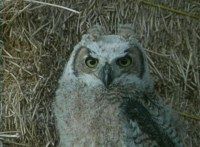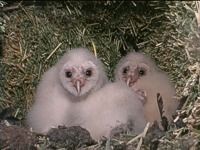My Cart
Your Shopping Cart is currently empty. Use Quick Order or Search to quickly add items to your order!

Using their keen vision and hearing, most owls silently swoop down upon their unsuspecting prey and grab them with their talons. However, Flammulated Owls are one exception to this rule. These nocturnal owls, which feed almost exclusively on insects, use their bills to catch their prey in flight. Other owls pluck birds out of the air with their talons. Although owls do not dive into water after prey, they will skim its surface to snag fish or snakes. Some owls have even been observed standing on the shore of streams and plucking fish out of the water with their talons.
Owls such as Great Grey Owls, Boreal Owls, and Hawk Owls sometimes attack prey which has tunneled under snow. These owls use their keen hearing to locate their buried prey. If the owl misses its target, it may simply stomp around in the snow until the prey has been flushed out of hiding.
Great Horned Owls have a crude, but effective, method of flushing tree squirrels out of their nests. These owls slam into the side of the nests with enough force to send the terrified squirrels scurrying for better cover. However, at least one unlucky squirrel usually ends up in the clutches of the hungry owl.
Hunting patterns are often developed by owls when they observe their prey coming back to the same place time after time. Great Horned Owls have been observed making repeated raids on colonies of ducks that return to a specific area to nest. Barn Owls sometimes follow a methodical hunting schedule when prey is readily available. They hunt 3 times a day, with the first hunt at around sunset, the second hunt at around midnight, and the third hunt at around sunrise.
Great Horned Owls have been known to prey on domestic animals such as cats, small dogs, and fowl. Even domesticated birds as large as turkeys have fallen prey to the Great Horned Owl. These owls have also been known to torment farmers who have poorly designed chicken coops by somehow opening the coop and snatching the chickens inside while they sleep.
Male Barn Owls use a special call to attract females to their territory. The courtship often involves the male and female chasing each other in flight while both call out loudly to one another. Male Barn Owls also exhibit a special courtship behavior known as “moth flight.” During this ritual, the male hovers in front of a perched female to display the distinctive white areas on its chest and belly.
Another mating ritual performed by owls involves the male repeatedly flying from a female’s nest to his own to get her attention. If the female is impressed, she will respond with a unique mating call similar to that of chicks begging for food. The male responds to this call by bringing a freshly caught animal as an offering to the female. The acceptance of this offering often leads to copulation.
Some owls, such as Screech Owls, appear to be monogamous throughout life. However, the pair-bond relationship of other owl species may last for only one brood. Barn Owls raise multiple broods in a single year if there is an abundance of prey. They may pick different mates for each brood. Barn Owls may also have more than one brood if an early brood is lost to disease, malnutrition, predators, or catastrophic weather.
 Owls usually begin a nesting phase during the mating period, but they are not known for being diligent or skillful nest builders. A lot of owls simply take over the nest that some other bird or animal has made. Once a good nest is found, owls may use it year after year.
Owls usually begin a nesting phase during the mating period, but they are not known for being diligent or skillful nest builders. A lot of owls simply take over the nest that some other bird or animal has made. Once a good nest is found, owls may use it year after year.
As the mating season draws near, female owls begin acting as if they are brooding even before there are eggs. After an egg is fertilized (usually within a day or 2), it goes through several stages of development. The developing egg, which is known as the yolk, initially picks up several coatings of albumen (egg white). It then gets two coatings of a material that forms the familiar hard shell.
As soon as the first egg forms a shell, another egg begins to develop. The first egg may be ready to lay as early as one day after copulation. Initially, eggs are laid individually every 1 to 2 days, but the cycle becomes erratic after the first few eggs have been laid. Younger chicks are more vulnerable to starvation because it becomes harder to feed the entire brood as the number of hatched chicks increases. Several days or even weeks can separate the oldest egg from the newest.
During the incubation process, female owls rarely leave the nest except to defecate and get water. To help with incubation, female owls have a sparsely feathered brood patch on their bellies that has a higher percentage of blood vessels than other parts of the skin. Blood flow through these vessels creates a good source of heat for the eggs.
Although most owls begin incubating eggs as soon as the first is laid, others may wait for hours or days to begin. When the incubation begins immediately, some chicks hatch far sooner than others. This can lead to the older chicks helping to brood and feed the younger chicks. When prey is scarce, however, it can lead to the older chicks cannibalizing the younger ones.

Like all birds, owls are born with an egg tooth. This structure helps them chip away from within and break the tough eggshell. This tooth drops off a week or 2 after hatching. Although owls are born blind and have only a thin coat of down to protect them from cold weather, a thicker coat appears within a couple of weeks.
It doesn’t take long for owls to develop strength and alertness. Barn Owl chicks are notorious for their curious, wandering behavior.
Owlets often beg vocally for food. Since more predators lurk nearby, those owlets on the ground are much quieter than those nested in trees.
The parents of young owls provide them with food soon after they have hatched. Many species provide insects to their young in the early stages and whole rodents once the chicks become large enough. Spotted Owls rip off the heads of their prey so that digestion and owl pellet production are easier for the chicks. In some species, such as Great Horned Owls, the parents provide larger and larger prey as the owlets increase in size.
Many young owls take their first flight, or fledge, by the time they are 2 months old. Once an owl begins flying, parental support dries up. The parents may chase the young away or simply abandon their nests. The young are subsequently forced to feed themselves.